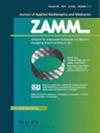Numerical study of Cattaneo‐Christov heat transfer in MHD Carreau‐Yasuda hybrid nanofluid subjected to Buoyancy force
IF 3.2
4区 工程技术
Q1 MATHEMATICS, APPLIED
Zamm-zeitschrift Fur Angewandte Mathematik Und Mechanik
Pub Date : 2023-07-27
DOI:10.1002/zamm.202300037
引用次数: 2
Abstract
Hybrid nanofluids (HNFs) have potentials applications in automotive industry, heating and cooling systems, biomedical and other fields due to their ability to introduce higher thermal conductivity than standard nanofluids. The purpose of this study is to investigate and compare the thermal transport performance (in the presence of buoyancy force) of two sets of HNFs. The hybrid nanoparticles which is the combination of titanium carbide and aluminium oxide, and the combination of titanium carbide‐copper oxide are taken into account. Both types of hybrid nanoparticles are dispersed in C2H6O2$C_{2}H_{6}O_{2}$ as a subjective fluid over a vertical nonlinear stretching sheet embedded in a porous medium. This will be the first study on the MXene base material TiC$TiC$ , making it possible for MXene‐based materials to enter the fluid dynamics field. Further, MXene material as heat transporting material is studied less and much more is needed for explore its various aspect. The specific combination of Al2O3−TiC$Al_{2}O_{3}-TiC$ , and CuO−TiC$CuO-TiC$ is considered because of their promising thermophysical and thermal transport properties. Moreover, considered combination of nanoparticles and the base fluid form a mixture which has thermal relaxation characteristics due to which its deviates from classical Fourier law of heat conduction. Therefore, instead of conventional Fourier's law of heat conduction, the non‐Fourier law of heat conduction is used to formulate the energy equation. It is first time that fhe finite element of method (FEM) is used for such a coupled and nonlinear complex problems of computational fluid dynamics (CFD). The numerical and graphical impacts of magnetic fields, Grashof number, permeable parameter, and thermal relaxation time parameter on velocity, and heat transport are investigated by applying FEM on formulated boundary value problems. In each studied system, increasing the Hartmann number causes an increase the skin friction coefficient and a decrease in the Nusselt number. Moreover, by increasing the thermal relaxation parameter, the temperature of the fluid decreases significantly. The velocity of the modified nanofluids is directly proportional to the Grashof number. The thermal boundary layer thickness (TBLT) and momentum boundary layer thickness (MBLT) of Carreau‐Yasuda (CY)‐HNF (Set II) is greater than CY hybrid nanofluid (CY‐HNF) (Set I) and CY‐Nanofluid (NF), respectively. We believe that the current research work provides new insights to improve the heat transport of nanofluid using appropriate combination of hybrid nanoparticles for practical application.浮力作用下MHD - Carreau - Yasuda混合纳米流体Cattaneo - Christov换热的数值研究
本文章由计算机程序翻译,如有差异,请以英文原文为准。
求助全文
约1分钟内获得全文
求助全文
来源期刊
CiteScore
3.30
自引率
8.70%
发文量
199
审稿时长
3.0 months
期刊介绍:
ZAMM is one of the oldest journals in the field of applied mathematics and mechanics and is read by scientists all over the world. The aim and scope of ZAMM is the publication of new results and review articles and information on applied mathematics (mainly numerical mathematics and various applications of analysis, in particular numerical aspects of differential and integral equations), on the entire field of theoretical and applied mechanics (solid mechanics, fluid mechanics, thermodynamics). ZAMM is also open to essential contributions on mathematics in industrial applications.

 求助内容:
求助内容: 应助结果提醒方式:
应助结果提醒方式:


